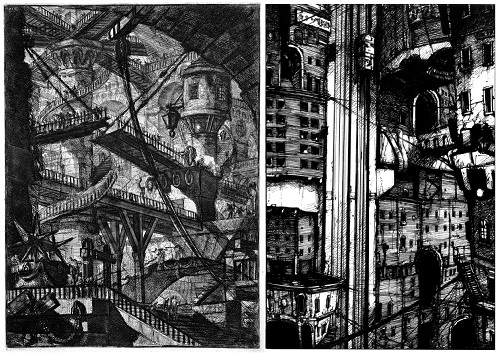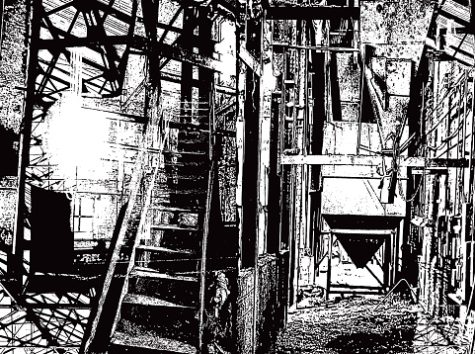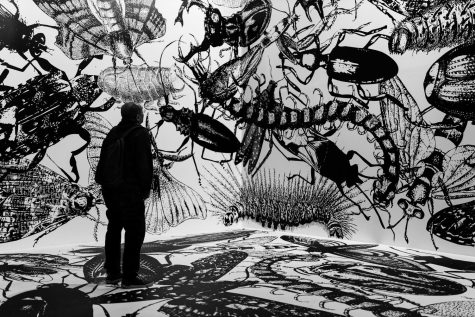Nihei’s style is special

Kevin Oliver writes about the artwork and writing of Tsutomu Nihei.
May 5, 2022
Tsutomu Nihei is a contemporary manga artist whose sci-fi art style is truly something special. However, before I delve into his art, I want to look at the man himself.
Prior to joining the manga scene, Nihei worked in construction, attended the Parsons School of Design for 11 months and had a brief tenure at an architectural design firm in Japan. His introduction to the manga world started through an assistant job under mangaka Tsutomu Takahashi. Nihei began working in the manga industry during the mid 90s as an assistant. It wasn’t until 1997 that he’d be able to publish his own manga titled “Blame!”
While it stands as its own unique body of work, it’s equally important to acknowledge one of Nihei’s biggest influences: William Gibson who is also known as the father of cyberpunk. Like many sci-fi enthusiasts, Nihei has read “Neuromancer” and cites it as one of his inspirations but while Gibson loves to delve into the nuances of being human, Nihei prefers to flesh out and explore settings that can only be crafted from our imaginations. His fascination with settings is most apparent in the two mangas he “really wanted to draw” called “Biomega” and “Blame!”
“Blame!”
Trying to describe “Blame!” is a little difficult. Much of the story revolves around the main character walking from point A to point B. During one segment, the protagonist walks through a foreign dimension for thirty years. It’s all about the journey, a mysterious one that Nihei purposely leaves the reader to piece together. Dialogue, though few and far between, offers small insights into the motivations of characters.
The motivation at the center of “Blame!” is a cyber dungeon quest to regain the net terminal gene spellbound to the main protagonist

Killy. Why does he need the net terminal gene? What is its purpose? How will it benefit him? All questions the reader is left to decipher. What Nihei doesn’t leave up to interpretation are his environments, the most expressive parts of “Blame!” that holds the weight of the storytelling.
This panel perfectly embodies how the environment carries the weight of storytelling. Killy and his companion, Cibo, stare at their beautifully grotesque environment.
Nihei’s background in architecture radiates on this page. You can really tell it was constructed by someone who fully comprehends the intricacies of a complex building. To understand the depth of the image, the viewer must stare deep into the image. Minute details scattered around collide into a presence no other artist could replicate. The illustration evokes the feeling not of a landscape that has been abandoned by life but of a landscape that has twisted and contorted itself so much that it has outgrown life. The inhuman structures that surround Killy and Cibo ooze with a profound sense of emptiness and desolation. It’s almost suffocating.
This image overrides the senses and funnels them to the shoes of the protagonist, demonstrating simply through showing how insignificant and miniscule the characters are compared to the world around them – ants traversing an Amazonian jungle. Is it possible for them to make a change in this world that doesn’t acknowledge them? Nihei’s art begs these sorts of questions; he’s managed to accomplish transfering the existential terror of cosmic horror from entities to environments.
“Biomega”
Nihei’s next title, “Biomega,” is more accessible. It’s his take on a zombie apocalypse and, while environmental storytelling definitely still has a strong presence, there’s also the addition of traditional storytelling. “Biomega” follows Zoichi Kanoe, an agent of Toha Heavy Industries, and his AI companion as they traverse a deteriorating world to bring it from the brink of virus-driven destruction. The virus itself is fairly fictionally traditional, turning people into brainless walking corpses, but the antagonists’ motivations for spreading it are unique. They want to proliferate the virus across the world until every person is infected using special technology that will allow them to reshape the genetics of every living being and reshape the world in their own image. At the core of this conflict is the battle between man and nature, along with what forms from their crucible.

This beautifully grotesque environment is the heart of “Biomega.” Humankind versus the nature that has provided for them. The setting is an empty space where a reader’s eyes are instantly focused on the megastructure at its center.
There’s a painful amount of detail within the structure and it’s clear Nihei took immense precision in crafting the scene, drawing heavily on his traditional design education. Rigid inorganic lines contrasted by an infectious loose growth that is consuming them. The inorganic sides are consistent, blocky and repeating while the organic portions of the structure follow no rhyme or reason, chaotic and uncontrollable. As much as the man-made side wants to triumph, to prove it deserves to exist, its efforts are futile in the face of the unstoppable force of nature. Their skirmish persists without foreseeable end. Fuyu’s luminous form hovers above it, unmoving and petrified. Will one side ever concede the other? Can peace be achieved, or is this battle eternal? This strange amalgamation of shapes and concepts has a depth only Nihei could have executed — an unidentifiable depth beyond all measure piercing space itself.
“Blame!” and “Biomega” are two of my favorite manga. Their environments and worlds are rich with storytelling that can only be found in the pages of Nihei’s works. With “Blame!” I love the scale of everything as each panel furthered my exploration in the dystopian landscape; where Killy seeks to conquer new scenery and environments around every corner.
The same goes for “Biomega,” the introduction of zombies added a twist to Nihei’s architectural style and exposed me to beautiful scenery that can only come from his mind. Nihei’s style is special and I can’t wait to see what he comes up with in the future.











